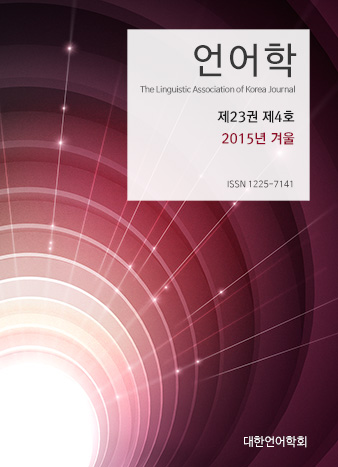대한언어학회 전자저널

23권 4호 (2015년 12월)
- The SVO Hypothesis in Korean: Word Order Variation, Head Movement and Linearization
-
Jeong-Shik Lee
Pages : 63-90
Abstract
Lee, Jeong-Shik. (2015). The SVO Hypothesis in Korean: Word Order Variation, Head Movement and Linearization. The Linguistic Association of Korea Journal 23(4), 63-90. This paper argues for the SVO hypothesis for Korean based on the discussions of word order variations and head movement phenomena displayed in one type of verb repetition construction. It is shown that the new SVO hypothesis is to be preferred to the previous SOV hypothesis. The results of the discussion suggest a more restricted way of obtaining verbal morphology in Korean, make it possible to apply Kayne's (1994) Linear Correspondence Axiom to Korean, and obviate the need of the head parameter, thereby reducing computational complexity and helping minimize UG (Chomsky, 2005).
Keywords
# word order variation # head movement # linearization # SOV hypothesis # SVO hypothesis
References
- Ahn, H.-D. and S. Cho. (2009). On the absence of CP ellipsis in English and Korean. Korean Journal of Linguistics, 34, 267-281.
- Biberauer, T. & Richards, M. (2006). True optionality: When the grammar doesn't mind. In C. Boeckx (Ed.), Minimalist essays (pp. 35-67). Amsterdam: Benjamins.
- Choi, K.-Y. (2003). Head movement in Korean finite clauses. Studies in Generative Grammar, 13, 119-142.
- Chomsky, N. (2005). Three factors in language design. Linguistic Inquiry, 36, 1-22.
- Chung, D. (2008). On the syntax of non-final predicate constructions in Korean. Proceedings of the 2008 Conference of the Korean Generative Grammar Circle, 6-16.
- Chung, D. (2009). An elliptical coordination analysis of the right dislocated construction in Korean. The Linguistic Association of Korea Journal, 17, 1-23.
- Chung, D. (2015). Some notes on Ko's (2015) hybrid approach to the Korean RDC. Proceedings of the 2015 Fall Conference of the Korean Generative Grammar Circle, 83-92.
- Fukui, N. and Takano, Y. (1998). Symmetry in syntax: Merge and demerge. Journal of East Asian Linguistics, 7, 27-86.
- Hornstein, N., Nunes, J., and Grohmann, K. (2005). Understanding minimalism. New York: Cambridge University Press.
- Huh, W. (1988). Kukehak [Korean linguistics]. Seoul: Saymmwunhwasa.
- Jo, J.-M. (2004). Grammatical effects of topic and focus information. Unpublished doctoral dissertation. University of Illinois at Urbana-Champaign.
- Jo, M. (1986). Fixed word order and the theory of the pre-verbal focus position in Korean. Doctoral dissertation. University of Washington, Seattle, WA.
- Kang, M.-Y. (1988). Topics in Korean syntax: Phrase structure, variable binding and movement. Doctoral dissertation. MIT, Cambridge.
- Kayne, R. (1994). The antisymmetry of syntax. Cambridge, MA: MIT Press.
- Ko, H. (2015). Two ways to the right: A hybrid approach to right-dislocation in Korean. Language Research, 51, 3-40.
- Koopman, H. (1984). The syntax of verbs: From verb movement in the Kru languages to Universal Grammar. Dordrecht: Foris.
- Koopman, H. (2005). Korean (and Japanese) morphology from a syntactic perspective. Linguistic Inquiry, 36, 601-635.
- Lee, J.-S. (1992). Case alternation in Korean: Case Minimality. Doctoral dissertation. University of Connecticut.
- Lee, J.-S. (1995). A study on predicate clefting. Studies in Generative Grammar, 5, 529-582.
- Lee, J.-S. (2007). Deriving SOV from SVO in Korean. The Linguistic Association of Korea Journal, 14, 109-129.
- Lee, J.-S. (2008). Notes on right dislocated constructions in Korean. The Linguistic Association of Korea Journal, 16, 47-68.
- Lee, J.-S. (2009). A verb-initial single clause analysis for right-dislocated constructions in Korean. Studies in Modern Grammar, 57, 127-157.
- Lee, J.-S. (2010a). Some remarks on NPI licensing. Studies in Generative Grammar, 20, 251-275.
- Lee, J.-S. (2010b). Why only predicate-final in embedded clauses in Korean? Studies in Modern Grammar, 61, 99-138.
- Lee, J.-S. (2010c). On the absence of embedded predicate ellipsis in Korean. The Linguistic Association of Korean Journal, 18, 125-145.
- Lee, J.-S. (2011a). Some loopholes of the double clause approach to the right dislocated construction in Korean. Studies in Modern Grammar, 63, 113-146.
- Lee, J.-S. (2011b). Layered VP and inner aspect. Studies in Modern Grammar, 65, 45-72.
- Lee, J.-S. (2012). Free word order variation, linearization, and strong minimalist thesis. The Linguistics Association of Korea Journal, 20, 81-104.
- Lee, J.-S. (2013). Replies to Chung (2012): On pre- vs. post-verbal asymmetries in Korean. Studies in Generative Grammar, 23, 171-197.
- Manetta, E. (2012). Reconsidering rightward scrambling: Postverbal constituents in Hindi-Urudu. Linguistic Inquiry, 43, 43-74.
- Nam, K.-S. and Ko, Y.-K. (1986). Pyocun kuke munpeplon [Standard Korean Grammar]. Seoul: Top Press.
- Nunes, J. (1999). Linearization of chains and phonetic realization of chain links. In Samuel David Epstein and Nobert Hornstein (eds.), Working minimalism, 217-249. Cambridge, MA: MIT Press.
- Paul, W. (2002). Proxy categories in phrase structure theory and the Chinese VP. Cahiers de Linguistique-Asie Orientale, 31, 137-174.
- Richards, M. (2008). Two kinds of variation in a minimalist system. In F. Heck, G. Müller & J. Trommer (Eds.), Varieties of competition. Linguistishce Arbeits Berichte, 87 (pp. 133-162). Universität Leibzig.
- Rizzi, L. (1997). The fine structure of the left periphery. In Liliane Haegeman (ed), Elements of grammar: Handbook in generative syntax, 281-337. Dordrecht: Kluwer.
- Sells, P. (1995). Korean and Japanese morphology from a lexical perspective. Linguistic Inquiry, 26, 277-325.
- Yang, J.-S. (2008). The morphosyntax of temporal elements in Korean. Korean Journal of Linguistics, 33, 693-722.
- Yoon, H.-S. (1989). A restrictive theory of morphosyntactic interaction and its consequences. Doctoral dissertation, University of Illinois at Urbana-Champaign.